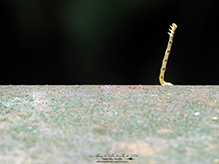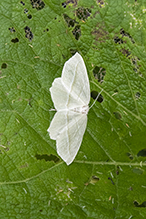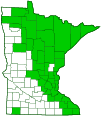pale beauty
(Campaea perlata)
Conservation • Description • Habitat • Ecology • Distribution • Taxonomy
|
|
||||||||||||||||||
Description |
Pale beauty is a common, medium-sized, typical geometer moth. In the United States it occurs in the east from Maine to northern Georgia, west to Minnesota and northern Arkansas; on the West Coast from northern Washington to central California; and along the Rocky Mountains from Montana to New Mexico. It is absent from the Great Plains, the desert west, and the deep south. It also occurs across Canada from Newfoundland and Labrador to Yukon (the name of the province was officially changed from “the Yukon” to simply “Yukon” in 2003) and in Alaska. In Minnesota it is common in the eastern half of the state, mostly absent from the western half. Pale beauty is found from early June through early September in deciduous, coniferous, and mixed forests, and in shrubby areas. Larvae are generalist feeders. They feed on the leaves of at least 65 species of trees and shrubs, including alder, ash, basswood, beech, birch, blueberry, cherry, cranberry, fir, elm, hemlock, maple, oak, pine, poplar, rose, spruce, tamarack, and willow. Adults have nonfunctional mouth parts and do not feed. Adults have a 1⅛″ to 2″ (28 to 51 mm) wingspan. The female is much larger than the male. The wings are translucent and are tinged to varying degrees with some shade of green. On the forewing, the antemedial (AM) line is white with a dark lower shadow, and the postmedial (PM) line is white with a dark upper shadow. Both lines are relatively straight and curve upward near the leading edge (costal margin). The PM line continues onto the hindwing, the AM line does not. The wings are otherwise unmarked. The fringe is pale. The antennae on the female are slender and thread-like. On the male the antennae are branched, feather-like, on both sides (bipectinate). The caterpillar, called fringed looper, is up to 1½″ (4 cm) long. The ground color may be gray, brick red, or occasionally smoky green. On the sides of the body the breathing pores (spiracles) are ringed with black. The underside of the body is noticeably flattened and pale. Most caterpillars have a pair of fleshy, leg-like structures (prolegs) on abdominal segment three (A3) through A6 and another on A10. Pale beauty has an extra set of prolegs on A5. On each side of the body there is a fringe of thickened pale hairs at the bottom. The fringe probably makes the caterpillar more difficult for predators to see. |
Size |
Wingspan: 1⅛″ to 2″ (28 to 51 mm) |
Similar Species |
Habitat |
Deciduous, coniferous, and mixed forests; shrubby areas |
Ecology |
Season |
Two generations per year in Minnesota: June through early September |
Behavior |
Adults are active at night and will come to lights. They spend the day on the underside of living leaves. They rest with their wings spread out. |
Life Cycle |
Third or fourth stage (instar) caterpillars overwinter on tree bark and on branches, probably fully exposed. |
Larva Hosts |
At least 65 species of trees and shrubs, including alder, ash, basswood, beech, birch, blueberry, cherry, fir, elm, hemlock, maple, oak, pine, poplar, rose, spruce, tamarack, and willow |
Adult Food |
|
Distribution |
||
|
Sources |
|
| 12/5/2024 | ||
Occurrence |
||
Common |
||
Taxonomy |
|
Order |
|
Superfamily |
Geometroidea (Geometrid and Swallowtail Moths) |
Family |
|
Subfamily |
Ennominae (Typical Geometers) |
Tribe |
Campaeini |
Genus |
Campaea |
Subordinate Taxa |
|
|
|
Synonyms |
|
Metrocampa perlaria Metrocampa perlata Metrocampa praegrandaria Metrocampa viridoperlata |
|
Common Names |
|
American light emerald American light emerald moth fringed looper (caterpillar) pale beauty pale beauty moth (adult) |
|
Glossary
Antemedial (AM) line
A thin line separating the basal area and the median area of the forewing of Lepidoptera.
Costal margin
The leading edge of the forewing of insects.
Postmedial (PM) line
A thin line separating the median area and the postmedial area of the forewing of Lepidoptera.
Proleg
A fleshy structure on the abdomen of some insect larvae that functions as a leg, but lacks the five segments of a true insect leg.
Spiracle
A small opening on the surface of an insect or arachnid through which it breathes.
Visitor Photos |
||
Share your photo of this insect. |
||
This button not working for you? |
||
Alfredo Colon |
 |
Greg Watson |
 |
MinnesotaSeasons.com Photos |
||
|
||
|

Visitor Videos |
||
Share your video of this insect. |
||
This button not working for you? |
||
|
Other Videos |
||
Pale Beauty Moth (Geometridae: Campaea perlata) on Wall |
About
Jul 3, 2011 Photographed at Nisswa, Minnesota (01 July 2011). Thank you to 'shotguneddie' (@Bugguide.net) for confirming the identity of this specimen! |
Pale Beauty Moth |
About
Jun 14, 2013 Campaea perlata |

Visitor Sightings |
||
Report a sighting of this insect. |
||
This button not working for you? |
||
Alfredo Colon |
Location: Albany, NY |
 |
| Greg Watson 6/19/2023 |
Location: Whitewater State Park, along the Trout Run Creek Trail |
MinnesotaSeasons.com Sightings |
||
|

Created: 6/27/2023 Last Updated: © MinnesotaSeasons.com. All rights reserved. |



